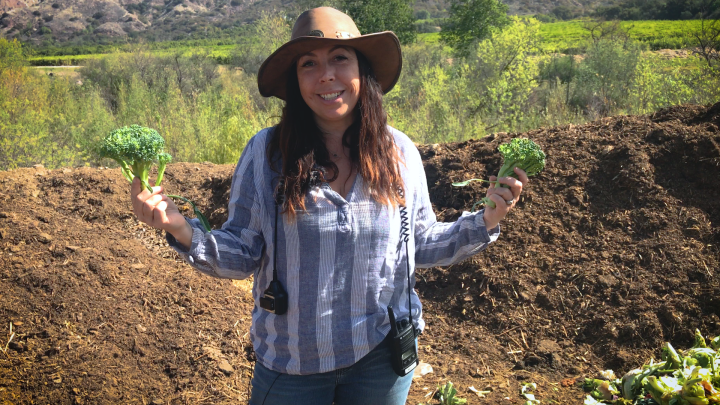
With “regenerative” farming, small growers can reap big profits for air and soil
With “regenerative” farming, small growers can reap big profits for air and soil

Mollie Engelhart’s Sow a Heart Farm in Fillmore, a town northwest of Los Angeles, doesn’t look anything like the orderly farms next door. Between the avocado trees are messy mixes of peppers, garlic, broccoli and cauliflower. But everything is planted somewhere for a reason.
“Fennel is actually an insectary. So the fennel is keeping the bugs off of the kale without spraying any pesticides or anything,” Engelhart said.
Recently harvested plots are patrolled by chickens and sheep, which eat the scraps, churn the dirt and poop out fresh fertilizer. This makes for healthier food and healthier soil.
Engelhart’s method of farming is some of the best carbon-capture technology around. It’s called regenerative agriculture, and it’s still far from the norm, but some farmers are using it to grow more sustainably. Environmentalists hope it will get some support in this year’s version of the farm bill — the legislation that determines the fate of farming livelihoods in the U.S. It’s reauthorized roughly every five years.
“By diversifying what you grow, you’re providing different kinds of nutrients to the soil,” said soil expert Arohi Sharma at the Natural Resources Defense Council. “It’s like diversifying our human diets.”
Better dirt supports more plants photosynthesizing, said Sharma — sucking carbon out of the atmosphere, shoving it through their roots into the ground and sending out oxygen.
If every U.S. farm operated like Engelhart’s does, Sharma estimated, the carbon removed would be comparable to shutting down 64 coal-fired power plants. But she said there’s a long way to go.
“From the 1970s onwards, decades of agricultural policy have prioritized unsustainable farming practices over regenerative ones,” she said. This means a farmer who has a bad year growing corn and soybeans can write a couple of claims, and the government helps them out. That’s more complicated for farmers like Engelhart, who grows 300 different crops.
“It’s a lot harder for them to write an insurance policy or claim insurance rewards because of just the number of crops that they have to keep track of,” Sharma said.
Engelhart said she grows more food per acre than the conventional farms next door. Some of it is served in her small chain of vegan restaurants. But four years in, her farm still hasn’t turned a profit.
“You can’t expect to be making money right away in any business. The guy down the street, the first four years he had lemons and avocados planted, he certainly wasn’t making money either,” she said.
Engelhart is hopeful that regenerative agriculture makes its way into the new farm bill. She said she gave up a suburban home and better job security to help the planet, hoping the money would follow.
“I was living in a golf course estate,” she said, “and had a good job and security. And now, I don’t have any of that kind of security. But I’m trying to do something to make a difference in a profound way.”
There’s a lot happening in the world. Through it all, Marketplace is here for you.
You rely on Marketplace to break down the world’s events and tell you how it affects you in a fact-based, approachable way. We rely on your financial support to keep making that possible.
Your donation today powers the independent journalism that you rely on. For just $5/month, you can help sustain Marketplace so we can keep reporting on the things that matter to you.














